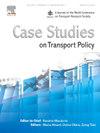Evaluating the effectiveness of automated scheduling at rural transit agencies in north carolina
IF 2.4
Q3 TRANSPORTATION
引用次数: 0
Abstract
Demand-response transit is the backbone of many rural transit systems. Demand-response transit provides riders with curb-to-curb service, not following fixed routes or schedules. While automated and semi-automated demand response scheduling has existed for decades, many agencies create schedules manually, using some form of computer-assisted schedule management. However, some transit agencies have recently adopted “microtransit” scheduling software packages that place an increasingly strong focus on fully automating the creation of schedules, and providing same-day service. In this article, we evaluate the recent implementation of automated scheduling software at two rural agencies in North Carolina.
We visited both agencies and conducted in-depth observations of their scheduling staff’s use of the software, as well as interviews with management. We found that neither agency used automated scheduling features of their software extensively. There were two main reasons for this. Firstly, automated scheduling was not seen as necessary; schedulers are experts on their regions and customers, and can create efficient schedules manually. Secondly, automated scheduling did not always match the service pattern of the agency, for instance by insufficiently prioritizing shared rides.
Agencies considering software purchases should consider what their needs and desires for a microtransit or automated scheduling system are. This process should involve both management and scheduling staff, to ensure the purchased system meets the needs of the agency. Automated scheduling and microtransit systems may not be a good fit for all agencies, particularly if existing scheduling practices are already working well.
评估北卡罗莱纳州农村交通机构自动调度的有效性
需求响应式交通是许多农村交通系统的支柱。需求响应式交通为乘客提供从路边到路边的服务,而不是遵循固定的路线或时间表。虽然自动化和半自动化的需求响应调度已经存在了几十年,但许多机构使用某种形式的计算机辅助调度管理手动创建调度。然而,一些运输机构最近采用了“微运输”调度软件包,将越来越多的重点放在完全自动化时刻表的创建上,并提供当日服务。在本文中,我们评估了北卡罗来纳州两个农村机构最近实施的自动调度软件。我们访问了这两家机构,深入观察了他们的调度人员对软件的使用情况,并与管理层进行了访谈。我们发现,这两家机构都没有广泛使用其软件的自动调度功能。这主要有两个原因。首先,自动化调度被认为是不必要的;调度员是他们所在地区和客户的专家,可以手动创建高效的调度员。其次,自动调度并不总是与机构的服务模式相匹配,例如,共享乘车的优先级不够。考虑购买软件的机构应该考虑他们对微交通或自动调度系统的需求和愿望。这个过程应该包括管理人员和调度人员,以确保购买的系统满足机构的需要。自动化调度和微运输系统可能并不适合所有机构,特别是如果现有的调度实践已经运行良好。
本文章由计算机程序翻译,如有差异,请以英文原文为准。
求助全文
约1分钟内获得全文
求助全文

 求助内容:
求助内容: 应助结果提醒方式:
应助结果提醒方式:


